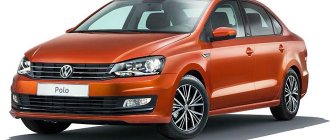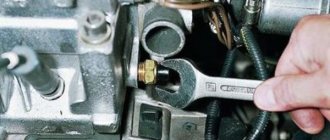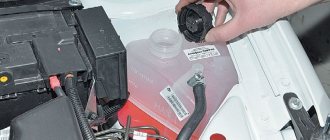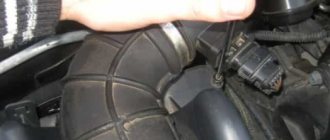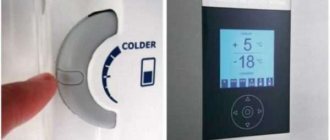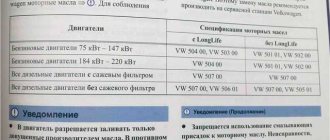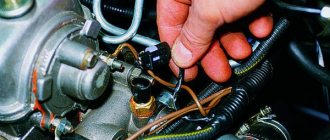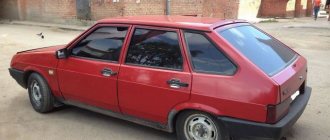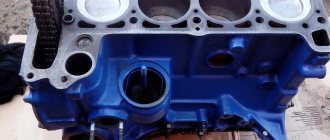Coolant is an important resource of the engine system. With its help, the car maintains the optimal engine temperature, which helps preserve its service life. The coolant must be changed every 25-35 thousand km. For safety reasons and according to the manufacturer's instructions. If the car is used in difficult operating conditions (severe frosts or extreme heat), then it is necessary to replace the antifreeze every 15 thousand km or a year of operation.
The main sign of a quick coolant change is engine overheating. When the indicator on the instrument panel begins to float and move away from a stable temperature. Most often this happens in the summer, when the coolant cannot cope with the load of natural and engine temperatures. In this case, it is necessary to urgently replace the coolant, having first cleaned the system of old antifreeze.
When does an Opel Astra N need antifreeze replacement?
The deadlines prescribed by the manufacturer in the regulations are nothing more than recommendations.
The technical documentation of cars indicates that the time for replacing antifreeze depends on operating conditions. That is, 45 thousand kilometers (or at least once every two years) recommended by Opel refer to medium-intensity conditions. With regard to Astra N, sold in Russia, this is traffic in mid-latitude regions, smooth road surfaces, etc. It is quite natural that in the Far North these figures will change. In more favorable cases, replacement is not required even after more than hundreds of thousands of kilometers. IT IS IMPORTANT TO KNOW! The time for replacing the coolant should be determined by the driver himself, based on the recommendations, but based on the signs of the need for the procedure.
Among the signs are:
- Change in liquid color. It becomes darker, and when dirt gets into the system, scale forms or as a result of corrosion, sediment may be noticeable in its composition. The difficulty is that these negative factors gradually reduce the effectiveness of the liquid to zero, and their traces can be seen when draining.
- Odor appears. He is quite unpleasant and harsh.
- Formation of coolant leaks. This occurs due to damage to the cooling system. Most often - at joints. Noticeable by engine overheating and rapid loss of fluid in the expansion tank.
In our car service center, any damage to the cooling system will be repaired quickly and competently, so that problem areas will no longer cause concern in the future. The replacement of antifreeze is also carried out promptly.
Why does the Opel Astra H require antifreeze replacement?
Inevitably, overheating of the motor leads to the fact that it will not work correctly, its components and parts will fail one after another, which will lead to major expensive repairs. Clogging of channels, precipitation, freezing and a decrease in the efficiency of the coolant also lead to the fact that the car owner thinks about what will be cheaper - to repair, sell at a bargain price or simply scrap his Opel Astra N.
In this regard, it is necessary to promptly replace the antifreeze and check the performance of the cooling system. This operation can be preventive (before obvious signs of problems) and mandatory. The latter applies to the following cases:
- the coolant exhausts its lifespan;
- using a type or mixture that is not appropriate for the make and model of the vehicle;
- system damage leading to coolant leaks.
Most often people contact us about leaks when they notice that fluid has begun to leak from the radiator, pump, or at connections. The following are also subject to wear: hoses, pipes, clamps, O-rings, gaskets.
FOR REFERENCE: Another reason for contacting auto repair technicians is a decrease in the performance of the cooling system due to the formation of air locks. They appear quite often when car enthusiasts independently replace antifreeze. Attempts to remove traffic jams yourself using chemicals are a temporary measure. It is better to replace the antifreeze again, but according to all the rules. Our technicians will easily fix this problem.
HOW MUCH OIL IS IN THE OPEL ASTRA ENGINE
First generation Opel Astra F (1991 – 1997)
The first generation Opel Astra came in sedan, hatchback and station wagon versions, and there was also a version for transporting cargo. The lineup was diversified by sports variants GT and GSI, and later a convertible was added. The front-wheel drive car was equipped with a variety of engines from 1.4 to 2 liters with a five-speed manual or four-speed automatic. The basic equipment was equipped with power steering and a cabin filter. There are options for a leather interior, air conditioning, and airbags. In 1994, the appearance of the car changed and restyling was performed.
First generation engines 1991 – 1997
Gasoline engines
- 1.4 C14NZ (60 hp) – oil volume 3.5 liters; API SF/SG approvals; SAE 10W-40/20W-50; ACEA A3;
- 1.4 X14NZ (60 hp) – oil volume 3.5 liters; API SF/SG approvals; SAE 10W-40/20W-50; ACEA A3;
- 1.4 14NV (75 hp) – oil volume 3.5 liters; API SF/SG approvals; SAE 10W-40/20W-50; ACEA A3;
- 1.4 C14SE (82 hp) – oil volume 3.5 liters; API SF/SG approvals; SAE 10W-40/20W-50; ACEA A3;
- 1.4 X14XE (92 hp) – oil volume 3.5 liters; API SF/SG approvals; SAE 10W-40/20W-50; ACEA A3;
- 1.6 X16SZ (71 hp) – oil volume 3.5 liters; API SF/SG approvals; SAE 10W-40/20W-50; ACEA A3;
- 1.6 X16SZR (75 hp) – oil volume 3.5 liters; API SF/SG approvals; SAE 10W-40/20W-50; ACEA A3;
- 1.6 X16XEL (101 hp) – oil volume 3.5 liters; API SF/SG approvals; SAE 10W-40/20W-50; ACEA A3;
- 1.8 C18NZ (90 hp) – oil volume 4.0 liters; API SF/SG approvals; SAE 10W-40/20W-50; ACEA A3;
- 1.8 C18XEL (115 hp) – oil volume 4.0 liters; API SF/SG approvals; SAE 10W-40/20W-50; ACEA A3;
- 1.8 Z18XE (125 hp) – oil volume 4.0 liters; API SF/SG approvals; SAE 10W-40/20W-50; ACEA A3;
- 1.8 X18XE (115 hp) – oil volume 4.0 liters; API SF/SG approvals; SAE 10W-40/20W-50; ACEA A3;
- 2.0 X20XEV (136 hp) – oil volume 4.25 liters; API SF/SG approvals; SAE 10W-40/20W-50; ACEA A3;
- 2.0 C20XE (150 hp) – oil volume 4.5 liters; API SF/SG approvals; SAE 10W-40/20W-50; ACEA A3;
- 2.0 C20NE (150 hp) – oil volume 4.0 liters; API SF/SG approvals; SAE 10W-40/20W-50; ACEA A3;
- 2.0 C20LET (204 hp) – oil volume 4.5 liters; API SF/SG approvals; SAE 10W-40/20W-50; ACEA A3;
Also read: Engine oil for Opel Insignia engine
Diesel engines
- 1.7 17D (57 hp) – oil volume 5.0 liters; API CC/CD/C approvals; SAE 10W-40/20W-50; ACEA B3/B4;
- 1.7 17DR (60 hp) – oil volume 5.0 liters; API CC/CD/C approvals; SAE 10W-40/20W-50; ACEA B3/B4;
- 1.7 X17DTL (68 hp) – oil volume 5.5 liters; API CC/CD/C approvals; SAE 10W-40/20W-50; ACEA B3/B4;
- 1.7 X17DT (82 hp) – oil volume 5.5 liters; API CC/CD/C approvals; SAE 10W-40/20W-50; ACEA B3/B4;
Second generation Opel Astra G (1998 – 2004)
The second generation Opel Astra was designed as a completely new car, with improved driving performance, aerodynamics, body strength, and an updated design. Seat belts and airbags were improved, and weld sealing technology was used, which increased the durability of the body. The second generation featured three design variations - sedan, hatchback and station wagon. Since 1999, a coupe appeared; in 2001, the Opel Astra Cabrio convertible was released on its basis. In some countries, the production of cars of this generation continued even after the appearance of subsequent generations, until 2008.
Second generation engines 1998 – 2004
Gasoline engines
- 1.2 X12XE (65 hp) – oil volume 3.5 liters; API SF/SG approvals; SAE 10W-40/20W-50; ACEA A3;
- 1.2 Z12XE (75 hp) – oil volume 3.5 liters; API SF/SG approvals; SAE 10W-40/20W-50; ACEA A3;
- 1.4 X14XE (90 hp) – oil volume 3.5 liters; API SF/SG approvals; SAE 10W-40/20W-50; ACEA A3;
- 1.4 Z14XE (90 hp) – oil volume 3.5 liters; API SF/SG approvals; SAE 10W-40/20W-50; ACEA A3;
- 1.6 X16SZR (75 hp) – oil volume 3.5 liters; API SF/SG approvals; SAE 10W-40/20W-50; ACEA A3;
- 1.6 Z16SE (84 hp) – oil volume 3.25 liters; API SF/SG approvals; SAE 10W-40/20W-50; ACEA A3;
- 1.6 Z16YNG (94 hp) – oil volume 3.5 liters; API SF/SG approvals; SAE 10W-40/20W-50; ACEA A3;
- 1.6 Z16XE (101 hp) – oil volume 3.5 liters; API SF/SG approvals; SAE 10W-40/20W-50; ACEA A3;
- 1.8 X18XE1 (116 hp) – oil volume 4.25 liters; API SF/SG approvals; SAE 10W-40/20W-50; ACEA A3;
- 1.8 Z18XE (125 hp) – oil volume 4.3 liters; API SF/SG approvals; SAE 10W-40/20W-50; ACEA A3;
- 2.0 X20XEV (136 hp) – oil volume 4.25 liters; API SF/SG approvals; SAE 10W-40/20W-50; ACEA A3;
- 2.0 Z20LEL (160 hp) – oil volume 4.25 liters; API SF/SG approvals; SAE 10W-40/20W-50; ACEA A3;
- 2.0 Z20LET (192 hp/200 hp) – oil volume 4.25 liters; API SF/SG approvals; SAE 10W-40/20W-50; ACEA A3;
- 2.2 Z22SE (147 hp) – oil volume 5.0 liters; API SF/SG approvals; SAE 10W-40/20W-50; ACEA A3;
Diesel engines
- 1.7 X17DTL (68 hp) – oil volume 5.5 liters; API CC/CD/C approvals; SAE 10W-40/20W-50; ACEA B3/B4;
- 1.7 Y17DT (75 hp) – oil volume 4.5 liters; API CC/CD/C approvals; SAE 10W-40/20W-50; ACEA B3/B4;
- 1.7 Z17DTL (80 hp) – oil volume 4.5 liters; API CC/CD/C approvals; SAE 10W-40/20W-50; ACEA B3/B4;
- 2.0 Y20DTL (82 hp) – oil volume 5.5 liters; API CC/CD/C approvals; SAE 10W-40/20W-50; ACEA B3/B4;
- 2.0 Y20DTH (101 hp) – oil volume 5.5 liters; API CC/CD/C approvals; SAE 10W-40/20W-50; ACEA B3/B4;
- 2.0 X20DTH (100 hp) – oil volume 5.5 liters; API CC/CD/C approvals; SAE 10W-40/20W-50; ACEA B3/B4;
- 2.2 Y22DTR (120-125 hp) – oil volume 5.5 liters; API CC/CD/C approvals; SAE 10W-40/20W-50; ACEA B3/B4;
Third generation Opel Astra H (2004 – 2010)
The third generation of Opel Astra has increased in size compared to the previous generation, technical characteristics and efficiency have improved. The body modification remains the same. In Russia, this model was very popular, was one of the ten best-selling foreign cars, and the secondary market is still saturated with generation H. In 2007, restyling took place, a new radiator grille appeared, optics came out in a lighter design, and the bumper was slightly changed. The third generation was produced even after the release of the next generation, until 2014.
Third generation engines 2004 – 2010
Gasoline engines
- 1.4 Z14XEP (90 hp) – oil volume 3.5 liters; approvals GM-LL-A-025; ASEA AZ; SAE from 0W-30 to 5W-40;
- 1.4 A14XER (100 hp) – oil volume 4.2 liters; approvals GM-LL-A-025; ASEA AZ; SAE from 0W-30 to 5W-40;
- 1.6 Z16XEP (103 hp) – oil volume 4.5 liters; approvals GM-LL-A-025; ASEA AZ; SAE from 0W-30 to 5W-40;
- 1.6 Z16XE1 (105 hp) – oil volume 4.5 liters; approvals GM-LL-A-025; ACEA AZ; SAE from 0W-30 to 5W-40;
- 1.6 A16XER (115 hp) – oil volume 4.5 liters; approvals GM-LL-A-025; ASEA AZ; SAE from 0W-30 to 5W-40;
- 1.6 Z16LET (180 hp) – oil volume 4.5 liters; approvals GM-LL-A-025; ASEA AZ; SAE from 0W-30 to 5W-40;
- 1.8 Z18XE (125 hp) – oil volume 4.25 liters; approvals GM-LL-A-025; ACEA AZ; SAE from 0W-30 to 5W-40;
- 1.8 Z18XER (140 hp) – oil volume 4.5 liters; approvals GM-LL-A-025; ACEA AZ; SAE from 0W-30 to 5W-40;
- 2.0 Z20LEL (170 hp) – oil volume 4.25 liters; approvals GM-LL-A-025; ACEA AZ; SAE from 0W-30 to 5W-40;
- 2.0 Z20LER (200 hp) – oil volume 4.25 liters; approvals GM-LL-A-025; ACEA AZ; SAE from 0W-30 to 5W-40;
- 2.0 Z20LEH (240 hp) – oil volume 5.0 liters; approvals GM-LL-A-025; ACEA AZ; SAE from 0W-30 to 5W-40;
Also read: Engine oil for Opel Insignia engine
Diesel engines
- 1.2 Z13DTH (90 hp) – oil volume 3.1 liters; approvals GM-LL-B-025; ACEA VZ; SAE 5W-30/5W-40;
- 1.7 Z17DTL (80 hp) – oil volume 4.5 liters; approvals GM-LL-B-025; ACEA VZ; SAE 5W-30/5W-40;
- 1.7 Z17DTH (101 hp) – oil volume 5.0 liters; approvals GM-LL-B-025; ACEA VZ; SAE 5W-30/5W-40;
- 1.7 A17DTJ (110 hp) – oil volume 5.4 liters; approvals GM-LL-B-025; ACEA VZ; SAE 5W-30/5W-40;
- 1.7 A17DTR (125 hp) – oil volume 5.4 liters; approvals GM-LL-B-025; ACEA VZ; SAE 5W-30/5W-40;
- 1.9 Z19DTL (100 hp) – oil volume 4.3 liters; approvals GM-LL-B-025; ACEA VZ; SAE 5W-30/5W-40;
- 1.9 Z19DTJ (120 hp) – oil volume 4.3 liters; approvals GM-LL-B-025; ACEA VZ; SAE 5W-30/5W-40;
- 1.9 Z19DT (120 hp) – oil volume 4.3 liters; approvals GM-LL-B-025; ACEA VZ; SAE 5W-30/5W-40;
- 1.9 Z19DTH (150 hp) – oil volume 4.3 liters; approvals GM-LL-B-025; ACEA VZ; SAE 5W-30/5W-40;
Fourth generation Opel Astra J (2010 – 2020)
In the fourth generation of Opel Astra, body modifications were reduced compared to previous generations; the model was produced in the form of a sedan, station wagon and hatchback. The J generation is based on General Motors' Delta II compact car platform. This generation embodied the updated corporate design and modern technical solutions from Opel, introduced in 2008 with the Opel Insignia. A diverse range of engines from 1.3 to 2 liters was equipped with three transmission options: five- and six-speed manual and six-speed Tiptronic automatic.
Fourth generation engines 2010 – 2020
Gasoline engines
- 1.4 A14XEL (87 hp) – oil volume 4.0 liters; Dexos 2 approvals; SAE from 0W-30 to 5W-40;
- 1.4 A14XER (100 hp) – oil volume 4.2 liters; Dexos 2 approvals; SAE from 0W-30 to 5W-40;
- 1.4 A14NEL (120 hp) – oil volume 4.0 liters; Dexos 2 approvals; SAE from 0W-30 to 5W-40;
- 1.4 A14NET (140 hp) – oil volume 4.0 liters; Dexos 2 approvals; SAE from 0W-30 to 5W-40;
- 1.6 A16XER (115 hp) – oil volume 4.5 liters; Dexos 2 approvals; SAE from 0W-30 to 5W-40;
- 1.6 A16XHT (170 hp) – oil volume 4.55 liters; Dexos 2 approvals; SAE from 0W-30 to 5W-40;
- 1.6 A16LET (180 hp) – oil volume 4.5 liters; Dexos 2 approvals; SAE from 0W-30 to 5W-40;
- 1.6 A16LER (192 hp) – oil volume 4.5 liters; Dexos 2 approvals; SAE from 0W-30 to 5W-40;
- 1.6 A16XHT Power Performance (200 hp) – oil volume 4.55 liters; Dexos 2 approvals; SAE from 0W-30 to 5W-40;
- 1.8 Z18XER (140 hp) – oil volume 4.5 liters; Dexos 2 approvals; SAE from 0W-30 to 5W-40;
- 2.0 A20NFT (280 hp) – oil volume 6 liters; Dexos 2 approvals; SAE from 0W-30 to 5W-40;
Diesel engines
- 1.3 A13DTE (95 hp) – oil volume 3.2 liters; Dexos 2 approvals; SAE from 0W-30 to 5W-40;
- 1.7 B16DTH (136 hp) – oil volume 5.0 liters; Dexos 2 approvals; SAE from 0W-30 to 5W-40;
- 1.7 A17DTE (110 hp) – oil volume 5.4 liters; Dexos 2 approvals; SAE from 0W-30 to 5W-40;
- 1.7 A17DTR (125 hp) – oil volume 5.4 liters; Dexos 2 approvals; SAE from 0W-30 to 5W-40;
- 1.7 A17DTF (130 hp) – oil volume 5.4 liters; Dexos 2 approvals; SAE from 0W-30 to 5W-40;
- 2.0 A20DTH (160/165 hp) – oil volume 4.5 liters; Dexos 2 approvals; SAE from 0W-30 to 5W-40;
- 2.0 A20DTR (195 hp) – oil volume 4.5 liters; Dexos 2 approvals; SAE from 0W-30 to 5W-40;
Also read: Engine oil for Opel Zafira engine
Fifth generation Opel Astra K (2015 – present)
The fifth generation was released on the D2XX/D2UX platform in a new body design, equipped with modern Matrix headlights. The range of engines has been diversified, and the total weight of the car has been reduced by 120 kg compared to the previous generation. In the interior of the cabin, the main place is occupied by a rather large touch display for controlling the car systems, navigation, and multimedia. The big advantage of the car remains its safety, which received the maximum number of stars from the European committee Euro NCAP.
Fifth generation engines 2020 – present
Gasoline engines
- 1.0 B10XFL (105 hp) – oil volume 4.0 liters; Dexos 2 approvals; SAE 5W-30;
- 1.4 B14XE (100 hp) – oil volume 4.0 liters; Dexos 2 approvals; SAE 5W-30;
- 1.4 B14XFL (125 hp) – oil volume 4.0 liters; Dexos 2 approvals; SAE 5W-30;
- 1.4 B14XFT (150 hp) – oil volume 4.0 liters; Dexos 2 approvals; SAE 5W-30;
- 1.6 B16SHT (200 hp) – oil volume 5.5 liters; Dexos 2 approvals; SAE 5W-30;
Diesel engines
- 1.6 B16DTE (95 hp) – oil volume 5.0 liters; Dexos 2 approvals; SAE 5W-30;
- 1.6 B16DTU (110 hp) – oil volume 5.0 liters; Dexos 2 approvals; SAE 5W-30;
- 1.6 B16DTH (136 hp) – oil volume 5.0 liters; Dexos 2 approvals; SAE 5W-30;
- 1.6 B16DTR (160 hp) – oil volume 5.0 liters; Dexos 2 approvals; SAE 5W-30;
Replacing coolant Opel Astra N
All manipulations of the procedure are divided into three stages: draining the old fluid, filling in a new one and preparing the cooling system for operation. Each stage has its own characteristics and includes additional work: checking operation, inspection, replacing worn parts, removing air locks, etc.
- Draining the old coolant:
- the car is installed on the inspection hole, the wheels and hood are fixed in the raised state of the Opel Astra H;
- the crankcase protection is dismantled;
- a thorough inspection of all elements of the system is carried out, the wear of parts is assessed;
- the radiator pipe clamp is removed, the fitting valve on the hose is unscrewed;
- The coolant is drained into a special container.
- Filling liquid:
- sediment in the radiator is removed by repeated flushing, alternating between turning the engine on and off;
- worn parts (clamps, seals, etc.) must be replaced;
- antifreeze is poured through the tank;
- the plug is returned, the hose clamps are tightened, and the tap is turned on.
- Preparing the cooling system for operation:
- the engine starts, the temperature (according to sensors) is brought to 40 degrees;
- antifreeze is added to the mark;
- air pockets are removed;
- the cooling system is inspected and tested for functionality.
IMPORTANT! Some novice car enthusiasts forget to release the pressure.
There is a risk of getting burned when antifreeze escapes from the neck. It is also harmful to the skin, vision and respiratory tract. The craftsmen strictly follow safety precautions in their work (ventilated box, gloves, and respirators for long-term work).
Conclusion
When choosing an oil, we first take into account two parameters - SAE viscosity and API quality. Using them, you can select high-quality oil for both gasoline and diesel engines of the Opel Astra H. So, as an example, we will give the oil option for the Astra H 2004 model year. For this car, it is preferable to fill in an all-season product on a semi-synthetic basis, with parameters 10W-40 SL. For later models (since 2013), it is preferable to use 0W-40 SN synthetics.
Recommended engine oils specifically for Astra H from the manufacturer:
- GM Dexos 2 5W-30
- Genesis Claritech 5W-30
- Liqui Moly 5W-30 Dexos 2.
Replacing antifreeze Opel Astra H: secrets of the masters
There are many secrets that professionals take into account, and which are not known to all motorists. Our masters share with some:
- Replacement is never made immediately and without delay after the client delivers the car to the service center. The engine must cool down.
- When you turn on the engine, as it warms up, the pressure increases, so during checking and bleeding, the expansion tank must be tightly closed.
- The hoses are compressed during injection to eliminate air pockets.
- Concentrates are not diluted with tap water, but only with distilled water.
- The fluid should not change color, become discolored or darken noticeably very quickly after replacement - in this case, the wrong type was used, the antifreeze was mixed incorrectly, or a cheap fake was used. It is not recommended to delay replacement, and when replacing, washing is required. Delaying this procedure risks destroying the radiator tubes and corroding seams and parts.
NOTE: Our service center uses different types of antifreeze from certified manufacturers; replacement is carried out taking into account operating conditions, compliance with the expiration date and coolant compatibility rules.
Opel Astra IV(J) from 2009 to 2015
The recommended engine oil for Opel Astra is selected depending on the engine type as follows.
Gasoline engines (including CNG, LPG, E85)
According to the manual, the following lubricants must be filled with the car:
- All European countries (except Belarus, Moldova, Russia, Serbia and Turkey):
- corresponding Dexos 2
- Israel only:
- according to Dexos 1 classification
The viscosity of the car oil is selected depending on the temperature behind the car:
- to a temperature of -25 °C, fill in SAE 5W-30 or SAE 5W-40;
- below -25 °C use SAE 0W-30 or SAE 0W-40.
If the required Dexos lubricant is not available, you can refill with ACEA classification C3 lubricant, but only once between scheduled replacements.
- All countries outside Europe except Israel:
- according to Dexos 1 classification;
- GM-LL-A-025;
- according to ACEA standard - A3/B3, ACEA A3/B4, ACEA C3
- in accordance with the classification API SM API SN (resource-saving liquids);
- Only Belarus, Moldova, Russia, Serbia and Türkiye:
- according to Dexos 2 classification;
- GM-LL-A-025;
- according to ACEA standards - A3/B3, ACEA A3/B4, ACEA C3
- in accordance with API specification - SM or SN (resource-saving oils).
The viscosity recommended by the manufacturer is selected based on the temperature of the region in which the car will be operated:
- up to a temperature of -25 °C use SAE 5W-30 or 5W-40;
- below -25 °C fill SAE 0W-30 or 0W-40;
- down to -20 °C use SAE 10W-30* or 10W-40*
* - The use of the specified oil is permitted, but it is recommended to use SAE 5W-30 or 5W-40 lubricants that meet the Dexos specification.
The amount of engine fluid required when replacing, taking into account the oil filter, is:
- Engines A14XEL, A14XER, A14NEL, A14NET - 4.0 l of lubricant;
- Motors A16LET, A16XER - 4.5 l.
Diesel power units
The recommended engine oil for Opel Astra must meet the following requirements:
- All European countries (except Belarus, Moldova, Russia, Serbia and Turkey):
- corresponding Dexos 2.
- Israel only:
- meeting Dexos 2 standards.
The viscosity parameters of lubricants are selected based on the temperature outside the machine, as follows:
- to a temperature of -25 °C, fill in SAE 5W-30 or 5W-40;
- if the thermometer shows a temperature below -25 °C, use SAE 0W-30 or 0W-40.
- All countries outside Europe except Israel:
- corresponding Dexos 2;
- GM-LL-B-025;
- according to ACEA standards - A3/B4 or C3.
- Only Belarus, Moldova, Russia, Serbia and Türkiye:
- meeting the Dexos 2 standard
- GM-LL-B-025
- according to ACEA standards - A3/B4 or C3.
The selection of viscosity characteristics of the lubricant is made depending on the temperature of the region in which the machine will be operated:
- in temperature conditions down to -25 °C use SAE 5W-30 or 5W-40;
- in the temperature range below -25 °C, fill in SAE 0W-30 or 0W-40;
- down to -20 °C use SAE 10W-30* or 10W-40*
* — The specified motor oil can be used, but it is recommended to use SAE 5W-30 or 5W-40 lubricants that meet the Dexos specification.
The volume of lubricant required for replacement, taking into account the oil filter, is:
- Auto engines A13DTE - 3.2 l;
- Power units A17DTE, A17DTC, A17DTF, A17DTS - 4.0 l;
- Engines A 17 DTJ, A17DTR - 5.4 l;
- Motors A20DTH - 4.5 l.
Replacing antifreeze Opel Astra H Z18XER
Clients often come to our car service center to refill new antifreeze on the Opel Astra Z18xer. It began its production in 2005. Using his example, we can consider some issues regarding the choice of antifreeze for replacement.
It uses silicate-free antifreeze. Kuhlerfrostschutz KFS 2001 Plus (art. 8840) will fit it, usually sold in 6.9 liter containers.
Concentrate 1940663 OPEL class G12 was recognized as optimal both in price and in terms of characteristics for filling this model. Allowed are TCL - LLC33121, LLC00741TCL and LLC01212TCL (listed in ascending order by price and use of different additives), as well as GENERAL MOTORS - 93742647, 93742646, MANNOL - 4036021157757 and the more expensive American GM - 1940678 GM.
Cooling Astra H
Z12XEP,Z14XEP,Z14XEL
Cooling system
| Engine | Z 12 XEP, Z 14 XEP, Z 14 XEL | |
| Coolant quantity | ||
| Manual Transmission | I | |
| without air conditioning | I | 5,6 |
| with air conditioning | l | 5,6 |
| Automatic transmission | l | — |
| Coolant pump | ||
| Design | Centrifugal pump | |
| Performance | l/min | 120 / 6000 |
| Thermostat | ||
| Design | bypass | |
| Start of opening | °C | 92 |
) Only use antifreeze approved by Opel (red) with a concentration of 50% water and 50% antifreeze. ) At a coolant temperature of 20°C.
Z16XEP,Z16XE1,Z16XER
| Engine | Z 16 XEP | Z16XE1 | Z16XER | |||
| Coolant quantity | ||||||
| Manual Transmission | ||||||
| without air conditioning | l | 6,1 | 5,9 | 6,9 | ||
| with air conditioning | l | 6,3 | ||||
| Coolant pump | ||||||
| Type | Centrifugal pump | |||||
| Feed intensity | l/min | 160 | ||||
| rpm | 6000 | |||||
| Thermostat | ||||||
| Type | Parametric control | |||||
| Start of opening | ||||||
| electric | °C | 90 | ||||
| thermal | °C | 105 | ||||
) Only use antifreeze approved by Opel with a concentration of 50% water and 50% antifreeze. ) At a coolant temperature of 20°C.
Z20LEL,Z20LER,Z20LEH
| Engine | Z 20 LEL, Z 20 LER, Z 20 LEH | |
| Coolant filling volume | ||
| Manual Transmission | ||
| with air conditioning | l | 7,7 |
| Coolant pump | ||
| Type | Centrifugal pump | |
| Feed intensity | l/min | 150 |
| at | rpm | 6000 |
| Thermostat | ||
| Type | bypass | |
| Start of opening | °C | 92 |
) Use only antifreeze 19 40 650 / 09 194 431 (red) and ensure a concentration of 50% water to 50% antifreeze. ) At a coolant temperature of 20°C.
Comments
Administration 06/17/2014 06:16
I quote
How much does the engine cost? Z**XEP or XER?
good afternoon. I have a z16xep20 engine, but lately I haven’t heard the fan, although the frieze is reset. I heard how it works before. I’m embarrassed to ask you. But can you tell me where the temperature sensor is located to turn on the fan. On the radiator? And another question if the valve of the big one does not work circle. At the same time, it can throw the frieze through the lid of the barrel. Or is this nonsense? So the first thing you need to look at is the fan! The sensor is located on the radiator. Of course, it can also be due to the thermostat, but when closed it almost never jams. Look at the fan! And it’s not a fact that the sensor is to blame!
Mitya 06/16/2014 15:51
How much does the engine cost? Z**XEP or XER? good afternoon. I have a z16xep20 engine, but lately I haven’t heard the fan, although the frieze is reset. I heard how it works before. I’m embarrassed to ask you. But can you tell me where the temperature sensor is located to turn on the fan. On the radiator? And another question if the valve of the big one does not work circle. At the same time, it can throw the frieze through the lid of the barrel. Or is this nonsense?
Administration 06/16/2014 09:05
I quote
good afternoon. I have a question, I have a 2005 Opel Astra. I dropped in to check the anti-freeze. I looked into the barrel and it was empty and there was some dirt on it. I don’t know why. I noticed a hole in the lower tube. I repaired it. I filled it with antifreeze. I drove it. I looked. It came out through the valve on the lid. And so on several times. I filled it less and to the level. I expelled the air. I pinched the hoses. I read about the covers, supposedly you need to install your own cover. I don’t know what kind it is, I’m not the first owner. Help, maybe I’m doing something stupid. And there’s a simple solution. except diagnostics
Good afternoon !
You need to understand the reason for the antifreeze being thrown out through the cap. Alternatively, the cooling fan may not work, as a result of which, at an elevated temperature, the antifreeze is thrown out through the plug. If everything is fine with the temperature, then replacing the cover is an option. It's better to see the car, of course. How much does the engine cost? Z**XEP or XER? Mitya 06/16/2014 08:55
good afternoon. I have a question, I have a 2005 Opel Astra. I dropped in to check the anti-freeze. I looked into the barrel and it was empty and there was some dirt on it. I don’t know why. I noticed a hole in the lower tube. I repaired it. I filled it with antifreeze. I drove it. I looked. It came out through the valve on the lid. And so on several times. I filled it less and to the level. I expelled the air. I pinched the hoses. I read about the covers, supposedly you need to install your own cover. I don’t know what kind it is, I’m not the first owner. Help, maybe I’m doing something stupid. And there’s a simple solution. except diagnostics
Opel Astra N coolant replacement with quality guarantee
If you:
- found signs of loss of quality of the coolant used (that is, its resource has been exhausted);
- Would you like to undergo preventive maintenance of the cooling system;
- you don’t have enough experience or don’t have extra time;
- accustomed to trusting professionals in choosing antifreeze;
- you don’t want to spend money on expensive major repairs because you postponed your visit to a car service center for a quick and simple procedure;
- want to have a guarantee of uninterrupted operation of the motor...
Contact our car service. Specialists will inexpensively and quickly replace the antifreeze.
